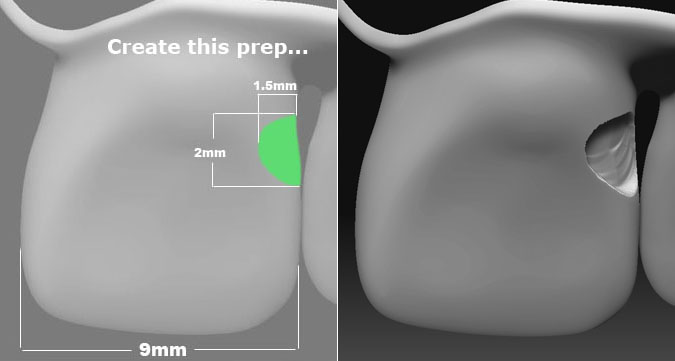 |
 |
 |
 |
Simulated Class-3 Tooth Preparation Effect on Subsequent Psychomotor Skill Acquisition
|
P.A. BAUER, M. FITZGERALD, S.K. GRAYDEN, E. MASLOWSKI, L.A. JOHNSON, K.-P. BEIER, and S.C. BAYNE, University of Michigan, Ann Arbor, USA | Click on images to view full size. Introduction: Enormous amounts of time are spent teaching psychomotor skills in dentistry. Elegant patient simulators have been tested to facilitate learning, but are expensive and have not reduced teaching effort. University of Michigan (http://um3d.dc.umich.edu/projects/vrdent/index.html) is testing a “low-cost simulation” (LCS) which focuses on separating psycho-and-motor learning events. It uses 3D images on laptop computers for previewing, conceptualizing, and performing preparations before actual laboratory experiences to improve performance.
Objective: Analyze LCS effects on DDS1 student experiences in operative dentistry for improved quality in Class-3 cavity preparations.
Methods: A pilot study (IRB-approved) was conducted (n=52 students) to evaluate the impact of using a computer-based 3D-Simulation program (ZBrush, V3.1, Pixologic) to prepare 8 simulated Class-3 preparations (see attached figure) 30-minutes prior to preparing typodont teeth in-lab. Computer-based and in-lab preparations were assessed for outline-form precision in 0.1 mm increments for inciso-gingival (I-C), mesio-distal (M-D), and/or facio-lingual (F-L) dimensions. In-lab F-L results in-lab served a negative control. Preparation dimensions among groups for each dimension were compared by 1-way ANOVA (p<0.05) with post-hoc t-tests (see superscripts below).
Group:
| Preparation Dimension=
(Ideal Dimension, d) | n=
| I-C
(d=2.0mm) | M-D
(d=1.5mm) | F-L
(d=1.5mm) | LCS Group | Pre-Lab Computer Practice | 28 | 2.4±0.6a | 1.5±0.3a | - - - - - - | LCS Group | In-Lab Mannequin Practice | 28 | 2.4±0.3a | 1.5±0.3a | 1.6±0.3a | Control Group | In-Lab Mannequin Practice | 24 | 2.6±0.4a | 1.7±0.3b | 1.7±0.2a | Results: For LCS pre-lab and LCS in-lab groups, I-C (p=0.82) and M-D (p=0.27) were not different. For LCS in-lab versus Control in-lab, I-C was not different (p=0.08), M-D was different (p=0.05) and was ideal, and F-L (the un-simulated dimension) was not different (p=0.48) as expected. For this simple model, there was preliminary evidence of an LCS effect.
Conclusions: Pilot data demonstrated some gain in cavity preparation quality using LCS and generated enthusiasm for further investigation.
Acknowledgments: UM-3D Lab, Pixologic Software. | | Seq #275 - Simulation and Clinical Skills in Dentistry
10:45 AM-12:15 PM, Saturday, July 5, 2008
Metro Toronto Convention Centre Room 711 |
|
Back to the Education Research Program
|
|
